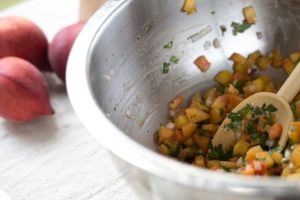Sweet peaches and jalapeños and other Southern-Latino love stories
By Liz Balmaseda – PalmBeachPost.com

Contributed by Sandra A. Gutierrez
Hot, peachy love: a peach salsa that tells the story of a region transformed by migrations.
When the sweet peach met the spicy jalapeño, a border-defying love story was sparked and life was made infinitely more delicious for Southern palates.
If you don’t believe me, pick up a tortilla chip and scoop up some of Sandra Gutierrez’s peach salsa.
Gutierrez, a North Carolina-based author and expert on Latin American cuisines, has been tracing Latin threads in the foods the South.
“An easy and simple analogy is this: When you drive down 1-95 and you pass into South Carolina and into Georgia, you begin to see signs among the trees, then the palm trees. Say ‘peach salsa.’ Really, it’s pico de gallo that’s made with different fruit,” Gutierrez said in a recent interview. Her cross-cultural culinary explorations are contained in her newly reissued cookbook, “The New Southern-Latino Table” (UNC Press).
Of course, long before there was peach salsa, there were Mississippi Delta hot tamales. While there are various theories about their origin, Gutierrez finds one most plausible: It was Mexican cotton field workers who introduced tamales to African American workers, “who then substituted readily available ingredients for traditional Mexican ones,” she writes in the book.
Fast-forward to today and you’ll find long, thin hot tamales, stuffed with boldly seasoned meat and simmered with cayenne and other spices, are ubiquitous in the Delta region. They are tamales, but no longer Mexican. They are their own thing. To find the Mexican essence in a Southern dish is a little like discovering the Latin bass line in rock-and-roll classics. Who gets bragging rights to the final product? Like hot tamales, the final product is a new expression.
Which brings us to one of Gutierrez’s core observations:
“I don’t believe a cuisine can be owned. People are loving the word appropriation these days. No one can own a cuisine. The world has been in a culinary flux since the very beginning,” Gutierrez told us by phone from her Cary, NC, home.
As people migrate, they bring with them their sense of cuisine and cooking techniques, she says. “Whoever is moving to the South, they are bringing ingredients. And the Southerners are taking a liking to them and including them in their food,” says the author and culinary instructor.
Today Gutierrez takes cooking inspiration from those Latino-Southern recipe exchanges. The woman who grew up in the United States and in her family’s native Guatemala puts jalapeños in her deviled eggs. She gives Carolina pulled pork a Mexican pibil treatment for mini sandwiches. She whips up a luxurious crab soup that echoes flavors of those enjoyed across South America. She gives Southern pickled shrimp a decidedly escabeche accent.
Gutierrez also finds these mingled accents when she dines at friends’ homes.
“I was at a dinner party at the edge of a golf course in Cary. Some friends invited me. They were serving barbecued goat that they had cooked on a spit in the backyard. There was barbecue sauce and chimichurri. And tostones. These are Southerners,” she recalled.
When she asked where they got the idea and the recipe, her friends told her they had tried “cabrito” (goat) on a trip.
“This is what makes it a movement. (The culinary influence) is not just one-directional. It is not restaurant or chef-promoted. This is happening organically. It started decades ago at peoples’ homes,” said Gutierrez, an active contributor to the Smithsonian’s current Latino-themed exhibit titled “Gateways/Portales.”
The author began to trace the non-seasonal flow of Latin Americans into the South in the 1990s. Many were escaping political strife and looking to establish roots there.
“I started noticing it in the food. My friends in the South were adding Latin ingredients to the food, like chipotle peppers added to barbecue sauce,” she said. “Potato salads were not just made in the Southern traditional style, but now layered in the Peruvian style. Even if the ingredients were the same, the seasonings would be different.”
She says she started picking up the scent of cilantro and cumin in foods. “That was new.”
Now it’s all part of a new Southern lexicon. If you think about it, the Southern-Latino mingling of foods makes perfect sense, says Gutierrez, who notes the cuisines of the American South as well as across Latin Americans are based on native, European and African influences.
“We have the exact same basket of ingredients – pork, corn, chiles, chocolate, squash, beans. We have the same cooking techniques – we grill, braise, fry,” she said. “It’s the way we interpret it together that created our different cuisines.”
RECIPES
The following recipe and author’s text are reprinted from Sandra A. Gutierrez’s cookbook, “The New Southern-Latino Table,” with permission of the publisher, University of North Carolina Press.

Seasonal peaches make salsa sweet. Jalapenos and cilantro make it a party. Jenni Girtman/ Atlanta Event Photography
Peach Salsa
In this new spin on a classic, peaches replace tomatoes, and the result is a healthy, colorful, and refreshing salsa. Whether you choose to eat it with tortilla chips or use it to dress grilled fish, this peachy take on traditional pico de gallo will satisfy your cravings for sweet, sour, and spicy flavors.
Select fresh peaches that are still firm, so their flesh will keep its shape when cubed. I prefer free-stone varieties, which have loose pits that release easily from the flesh, making them much simpler to slice. Frozen and thawed peaches may be used in lieu of fresh, but nothing beats the flavor of local, seasonal peaches. – Sandra A. Gutierrez
Makes 2 1/2 cups salsa
2 cups peeled and cubed fresh peaches (about 3 large peaches)
1/4 cup finely chopped red onion
1/4 cup finely chopped cilantro (leaves and tender stems)
2 tablespoons minced jalapeños (seeded and deveined if less heat is desired)
1 (2-ounce) jar diced pimientos, drained
2 teaspoons grated lime zest
Juice of 1 lime, or to taste
Salt and freshly ground pepper, to taste
Make the salsa
In a medium bowl, combine the peaches, onions, cilantro, jalapeños, pimientos, and lime zest. Add the lime juice and season with salt and pepper. Let the salsa sit at room temperature for 10 minutes before serving to allow the flavors to blend, or cover and chill until ready to use (for up to 24 hours).

